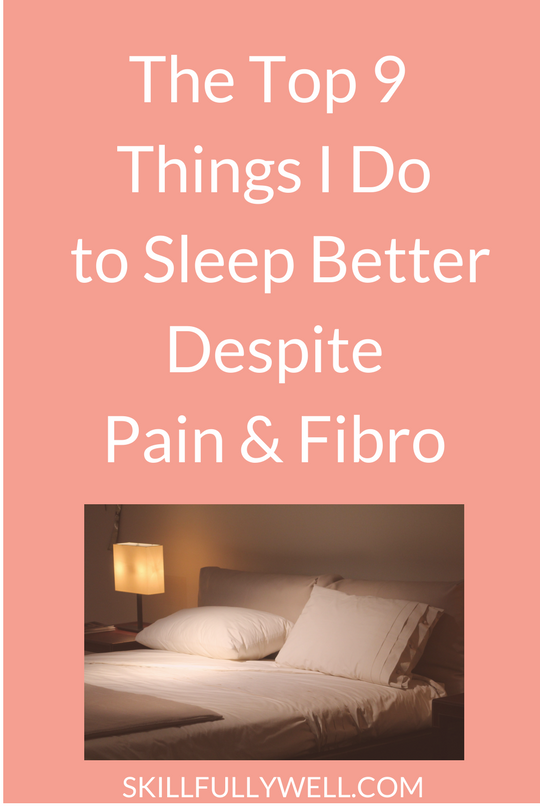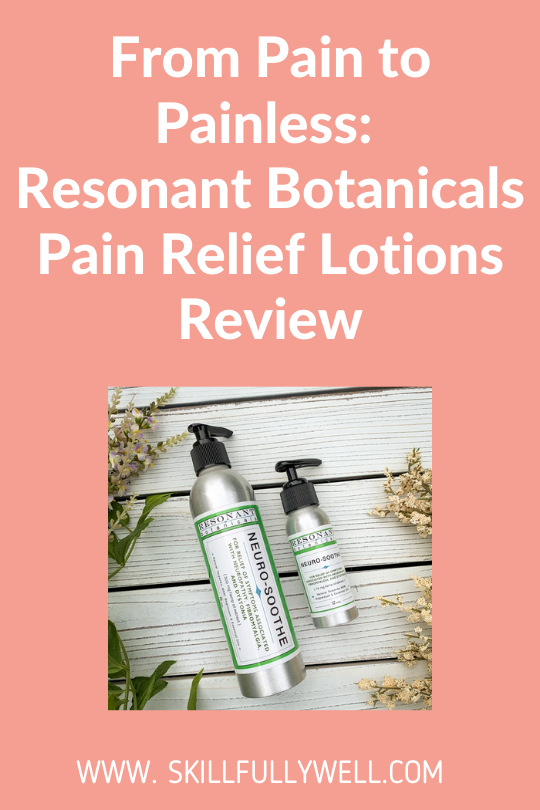Do you feel like ‘the Princess and the Pea’ when you try to get a restful sleep? Here are my top 9 recommendations for improving your quality of sleep if you live with fibromyalgia, chronic pain or chronic illness.After being my own guinea pig, I wanted to share the most effective non-drug, natural solutions I’ve found to beating ‘painsomnia’.

The never ending search for a good night’s sleep… if you have fibromyalgia, chronic pain, or chronic illness, you know what I’m talking about. Getting a good night’s sleep is one of my biggest challenges day-to-day. Almost everyone living with FM (or CFS, chronic pain or another chronic illness) can relate to this struggle. There seem to be so many obstacles to getting a full night of restful sleep:
- pain
- changes in how the brain regulates sleep/wake cycles (researchers have found that Fibromyalgia patients have disordered deep sleep – intrusions of ‘alpha waves’ associated with light sleep during deep sleep ‘delta waves’)
- hormonal changes, such as reduced production of growth hormone, responsible for night time tissue repair
- increased environmental sensitivity, such as to light or sound
Like a lot of other people with fibromyalgia, getting enough sleep is probably the single most important factor that determines my quality of life. In my case, I need to get about 9 hours of sleep to be able to function the next day. If I don’t, I am miserably exhausted and everything seems to go wrong – pain goes up, mood goes down and brain fog sets in.
A few years ago I did a sleep study. Before we move on, I would like to just say, for the record, that sleep studies really should be classified as a modern form of torture – what else can you call being forcibly held in place by many restraining wires, while watched through a Big Brother camera by the night guard, err, nurse?
Anyway, moving on… My sleep study showed that I woke up 66 times during the night, or about 14.3 times per hour. In addition, it found that my sleep efficiency was very low, at 64.5% (total time I was actually sleep divided by the time I lay in the bed). Basically, like many other people with chronic pain or illness, I’m just not getting a very restful sleep.
Over the years, I have tried countless supplements, medications, lifestyle changes, products and strategies to help me get a better night’s sleep. While most of these turned out to be ineffective, a number of them have significantly improved the quality of my sleep. I thought it might be helpful to share the results of being my own experimental guinea pig with you!
Quiet Down: Reducing Noise Distractions for Better Sleep
I think I might have actually become the world’s lightest sleeper since I developed fibromyalgia. I get woken up by trucks going by, my husband’s snoring, early commuters closing their car doors, my cat cleaning herself, my husband’s snoring, snowplough machines, dripping faucets, my husband’s snoring… You get the picture. Sudden noises are the bane of any insomniac’ s existence. Even if you don’t actually get woken up by a disruptive sound, it can disturb your sleep by shifting you from deep, restorative sleep into a lighter stage of sleep (Prevention). This is especially problematic for people with fibromyalgia, who already get less restorative sleep than the average person because of their illness.
1) Silicone earplugs: The first thing I tried to block out sound was, of course, earplugs. I tried all different kinds, and eventually settled on silicone earplugs. You might recognize these as a type of earplug used by some people when they go swimming to prevent swimmer’s ear infections. Instead of putting these plugs into the ear canal, the silicone molds to cover and seal the entrance to the ear canal. Personally, I find them more comfortable and effective than regular foam earplugs. For regular use, I think silicone earplugs are safer because there is less worry about damage from impacted earwax (caused by frequently pushing something into the ear canal).
2) White noise: But what if earplugs aren’t enough? This is where white noise enters the picture. White noise is a sound that contains many frequencies at the same intensity, like the sound of a fan, rainfall, or static on the radio (Prevention). By providing a constant, soothing background sound, white noise can blanket or drown out disruptive sounds that wake light sleepers. It works by reducing the noise differential between background noise and the disruptive sound – if the background sound is just silence, then a disruptive noise is very jarring, but if the background sound is white noise, then a disruptive sound is, well, less disruptive.
At first I wasn’t sure how adding noise would help me sleep better, when noise is what frequently wakes me up. But I found that I quickly adapted to the constant sound of the white noise. Best of all, I stopped being woken up by sudden noises!
Initially, I tried a number of free apps to play white noise on my phone. This is a good option to find out if white noise works for you. Over time, I found that my phone wasn’t able to play white noise loud enough to mask sounds like the neighbour’s leaf blower. Additionally, the app would sometimes cut out in the middle of the night and wake me up (yes, even sudden silence is enough to wake me). That’s when I found my new best friend, the LectroFan white noise machine. It is a small white machine that plays 10 types of white noises and 10 fan sounds. I really appreciated that it has a precise volume control so you can incrementally increase it to the right sound volume for you, and it can play a surprisingly loud sound for such a small machine. The best part is that it has an option to play continuously, instead of having an automatic shut off after a set period of time, like many other machines. Now, I’m never anxious that sudden sounds will wake me up because I know I can mask them with the white noise machine.
Lights Off: Why Darkness is Better for Sleep
Your body’s sleep-wake cycle is governed by light and dark. Darkness cues production of the sleep-inducing hormone melatonin to get you ready for a good night’s sleep. Unfortunately, artificial light can suppress the production of melatonin, which makes it hard to fall asleep and stay asleep (National Sleep Foundation). One of the simplest and most effective things you can do to improve your sleep is to reduce exposure to artificial light at night and early sunrise in the morning (unless you prefer to get up at the crack of dawn). Absolute darkness is an insomniac’s best friend. Here are the tips I have found most effective reduce light exposure:
3) Black-out Blinds: if you aren’t familiar with them, blackout blinds are made of specially treated material prevents light passing through them. In my experience, they’re one of the most effective ways to keep my room dark enough for a better night’s sleep. Whether streetlights, headlights or sunlight keep you up, blackout blinds are one of the best solutions. You can even buy portable black-out blinds for home or travel. Heavy drapes or curtains can also keep your room dark. Since I usually need to sleep in relatively late in the morning in order to get enough sleep to last through the day, blackout blinds have been a saving grace because they keep the sunlight out. However, it’s important to open all your drapes and curtains and blinds when you to get up, because sunlight in the morning helps to maintain a healthy sleep-wake cycle.
4) Sleep mask: in addition to blackout blinds, I often also use a sleep mask. That might seem like overkill, but indoor artificial light is another sleep disruptor for me. The lights from digital clocks, nightlights, computers/TVs, someone else making a midnight trip to the washroom, and many other sources can wake me up.
5) Blue Light Filter: Different wavelengths of light affect your brain differently. Researchers have found that blue light, which has a short wavelength, suppresses the release of melatonin to a greater extent than other wavelengths of light (National Sleep Foundation). Blue light is given off by electronics like computers and cell phones, as well as energy-efficient light bulbs. If you use one of these devices shortly before going to bed, you will probably find it more difficult to fall asleep or stay asleep. The best option is to simply turn off all of these electronics a couple of hours before going to sleep. The next best option is to install a blue light filter on your phone/tablet. By reducing the emission of blue light, you can reduce the negative impact of using the device on your sleep. Some phones come preinstalled with a blue light filter, like the Samsung Galaxy, but there are blue light filter apps for every type of phone or tablet. Often you can preset the filter to turn on automatically at a certain time in the evening, so you don’t even have to think about it.
Strange Bedfellows: Coping with ‘Painsomnia’
If you live with chronic pain, you have probably endured countless sleepless nights. Because insomnia often accompanies pain, the term ‘painsomnia’ was coined to describe this struggle. When my pain flares up, I sometimes see my bedroom as a torture chamber rather than on oasis of rest! After much experimentation, here are my recommendations for making your bed more comfortable so you can sleep better at night:
6) Neck Pillow: Personally, without a supportive neck pillow, I develop serious neck pain and migraines. Orthopedic or ergonomic neck pillows are often designed in a contoured wave-like form, and support the natural alignment of the head, neck and spine. If you sleep on your side, there are specially designed contour pillows for you (usually advertized in the product description). Materials like memory foam, latex or bamboo fibre help provide consistent, durable support. Orthopedic neck pillows are more costly than regular pillows,. In my experience, though, buying one is totally worth it! Pillows should be replaced every 1-2 years.
7) Customize Your Mattress: I’m pretty sure the ‘Princess and the Pea’ fairytale was written about a girl with fibromyalgia. A bed can feel like some sort of torture device to someone trying to sleep with chronic pain. I recently had to buy a new mattress because my nighttime back pain was too much to bear. In the process, I learned that there are many decently affordable online mattress vendors. Once you’ve selected a mattress, they ship it to you in a surprisingly small box, and give you a three month trial. If you decide to return it, you get your money back and the pickup service to retrieve the mattress is free. It was such a relief to know that I had enough time to test out my new mattress and, if I decided to return it, I didn’t need to worry about the cost.
8) Heated Mattress Pad: Unfortunately sometimes even the best mattress can feel uncomfortable to someone with chronic pain. My muscles become very tense at night while I sleep, and I often wake up quite stiff or with a muscle spasm. One of the best things I have discovered for improving my sleep quality is the existence of heated mattress pads. A mattress pad looks like a regular fitted sheet but it has small wires woven into the material that release a gentle heat. You can’t feel the wires at all, at least not sleeping on the heated mattress pad that I bought. There is a bedside dial that you use to adjust the heat level, and if you buy a queen-size one or larger, each side of the mattress pad has a separate dial for you and your partner. Sleeping on the gentle heat of the mattress pad all night has definitely reduced the number of muscles pain flare-ups I experience. I am less stiff and less sore when I get up in the morning, and I sleep better overall.
9) Mattress Topper: Another option to make your mattress more comfortable is to use a mattress topper – an extra layer to provide additional support while you sleep. I previously used a memory foam mattress topper on my old mattress, which I found helped to relieve pressure points by contouring to my specific shape. Another mattress topper option is the CuddleEwe, which uses specialty wool, and is designed to relieve pressure on your body contact points when lying down (ex. shoulders and hips) by diffusing weight better than a mattress can.
(This post contains affiliate links, but recommendations are based on my own opinions and have been in no way influenced by third parties. Anything you purchase through the affiliate links helps to support this blog, so if you are planning on doing some retail therapy anyway, consider clicking on the in-text links).













